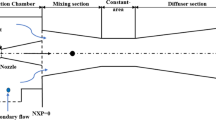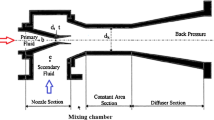Abstract
The supersonic nozzle is the most important device of an ejector-diffuser system. The best operation condition and optimal structure of supersonic nozzle are hardly known due to the complicated turbulent mixing, compressibility effects and even flow unsteadiness which are generated around the nozzle extent. In the present study, the primary stream nozzle was redesigned using convergent nozzle to activate the shear actions between the primary and secondary streams, by means of longitudinal vortices generated between the Chevron lobes. Exactly same geometrical model of ejector-diffuser system was created to validate the results of experimental data. The operation characteristics of the ejector system were compared between Chevron nozzle and conventional convergent nozzle for the primary stream. A CFD method has been applied to simulate the supersonic flows and shock waves inside the ejector. It is observed that the flow structure and shock system were changed and primary numerical analysis results show that the Chevron nozzle achieve a positive effect on the supersonic ejector-diffuser system performance. The ejector with Chevron nozzle can entrain more secondary stream with less primary stream mass flow rate.
Similar content being viewed by others
Abbreviations
- A :
-
cross-sectional area of primary stream nozzle exit (m2)
- D :
-
diameter (mm)
- L :
-
length (mm)
- C p :
-
specific heat (J/kg K)
- D ω :
-
cross-diffusion
- E :
-
energy (J/kg)
- G k , G ω :
-
generation of k and ω
- k :
-
turbulent kinetic energy (m2/s2)
- M :
-
Mach number at primary nozzle exit
- P :
-
pressure (Pa)
- P d :
-
dynamic pressure (Pa)
- Ps :
-
static pressure (or static pressure at nozzle exit if no subscript) (Pa)
- P t :
-
total pressure (Pa)
- ΔP :
-
pressure recovery
- R :
-
gas constant (J/kg K)
- Re :
-
Reynolds number
- Rm :
-
entrainment ratio
- S :
-
strain rate magnitude
- S k , S ω :
-
user-defined source
- T :
-
temperature (K)
- Ts :
-
static temperature (K)
- T t :
-
total temperature (K)
- t :
-
time (s)
- u i :
-
velocity components (m/s)
- \(\overline {u'_i } ,u'_i \) :
-
mean and fluctuating velocity components (m/s)
- \(\overline {u'_i u'_j } \) :
-
Reynolds-stress tensor
- V :
-
velocity of primary stream (m/s)
- x, y, z :
-
Cartesian coordinates
- Y k , Y ω :
-
dissipation of k and ω
- y + :
-
non-dimensional distance
- α :
-
thermal conductivity (W/m K)
- γ :
-
ratio of specific heats
- δij :
-
Kronecker symbol
- ṁ:
-
mass flow rate (or mass flow rate at nozzle exit if no subscript)(kg/s)
- ρ :
-
density (kg/m3)
- Γ k , Γ ω :
-
effective diffusivity of k and ω
- τ ij :
-
stress tensor
- µt :
-
turbulent viscosity (kg/m s)
- µ:
-
dynamic viscosity (Pa s)
- µeff :
-
effective viscosity (kg/m s)
- ω :
-
specific dissipation rate (m2/s3)
- 1 :
-
1st: values at nozzle exit
- 2 :
-
2nd: values at secondary stream inlet
- e,E :
-
exit of the supersonic ejector-diffuser system
- i, j :
-
unit vectors along x and y directions
- M :
-
mixing chamber
- D :
-
diffuser section
References
K. Chunnanond, S. Aphornratana, “Ejectors: Applications in Refrigeration Technology,” Renewable and Sustainable Energy Reviews, vol.8, No.2, 2004, pp. 129–155.
Y.M. Chen, C.Y. Sun, “Experimental Study of the Performance Characteristics of a Steam-Ejector Refrigeration System,” Experimental Thermal and Fluid Science, vol. 15, No. 4, 1997, pp. 384–394.
B.J. Huang, J.M. Chang, “Empirical Correlation for Ejector Design,” International Journal of Refrigeration, vol. 22, No. 5, 1999, pp. 379–388.
S. Aphornratana, I.W. Eames, “A Small Capacity Steam-Ejector Refrigerator: Experimental Investigation of a System using Ejector with Movable Primary Nozzle,” International Journal of Refrigeration, vol. 20, No. 5, 1997, pp. 352–358.
Z. Aidoun, M. Ouzzane, “The Effect of Operating Conditions on the Performance of a Supersonic Ejector for Refrigeration,” International Journal of Refrigeration, vol. 27, No.8, 2004, pp. 974–984.
Y. Bartosiewicza, Z. Aidouna, P. Desevauxb, Y. Mercadierc, “Numerical and Experimental Investigations on Supersonic Ejectors,” International Journal of Heat and Fluid Flow, vol. 26, No. 1, 2005, pp. 56–70.
V. Lijo, H.D. Kim, S. Matsuo, T. Setoguchi, “A Study of the Supersonic Ejector-Diffuser System with an Inlet Orifice,” Aerospace Science and Technology, available online 31 August, 2011.
X. Yang, X. Long, X. Yao, “Numerical Investigation on the Mixing Process in a Stream Ejector with Different Nozzle Structures,” International Journal of Thermal Sciences, vol.56, 2012, pp.95–106.
A.V. Sobolev, V.I. Zapryagaev and V.M. Mal’Kov, “Improvement of Gas-Jet Ejector Discharge Characteristics with Heads, Chevrons, and Tubs,” Thermophysics and Aeromechanics, Vol. 14, No. 2, 2007.
Gregory A. Blaisdell, Anastasios S. Lyrintzis and John P. Sullivan, “Preliminary Design and Computational Analysis of an Ejector Nozzle with Chevrons,” 49th AIAA Aerospace Sciences Meeting including the New Horizons Forum and Aerospace Exposition, Orlando, Florida, 2011.
D.V. Manohar, “Desalination of Seawater using a High-Efficiency Jet Ejector,” Master Thesis, Texas A&M University, College Station, USA, 2005.
W. Somsak, “Optimization of a High-Efficiency Jet Ejector by Computational Fluid Dynamics Software,” Master Thesis, Texas A&M University, College Station, USA, 2005.
W. Somsak, “CFD Optimization Study of High-Efficiency Jet Ejector,” Doctoral Dissertation, Texas A&M University, College Station, USA, 2008.
M.T. Holtzapple, “High-Efficiency Jet Ejector,” Invention Disclosure, Texas A&M University, College Station, USA, 2001.
F.S. Kong, H.D. Kim, Y.Z. Jin, T. Setoguchi, “Computational Analysis of Mixing Guide Vane Effects on Performance of the Supersonic Ejector-Diffuser System,” Open Journal of Fluid Dynamics, Vol. 2, 2012, pp.45–55.
S. Khalid, J. Sokhey, P. Chakka, and A. Pierluissi, “Ejector/ Engine/Nacelle Integration for Increased Thrust minus Drag,” 46th AIAA/ASME/SAE/ASEE Joint Propulsion Conference and Exhibit, Nashville, TN, USA, AIAA-2010-6501, 2010.
Author information
Authors and Affiliations
Rights and permissions
About this article
Cite this article
Kong, F., Jin, Y., Setoguchi, T. et al. Numerical analysis of Chevron nozzle effects on performance of the supersonic ejector-diffuser system. J. Therm. Sci. 22, 459–466 (2013). https://doi.org/10.1007/s11630-013-0648-4
Received:
Published:
Issue Date:
DOI: https://doi.org/10.1007/s11630-013-0648-4




